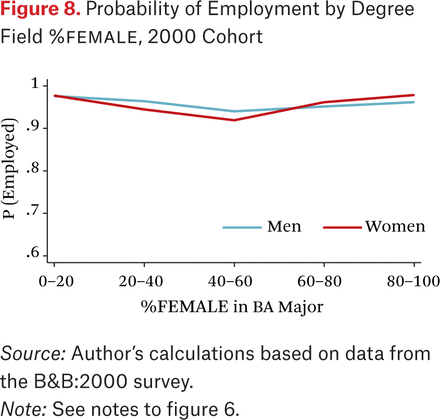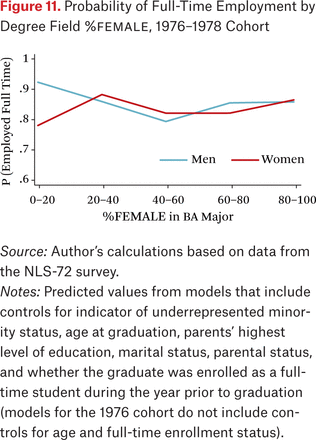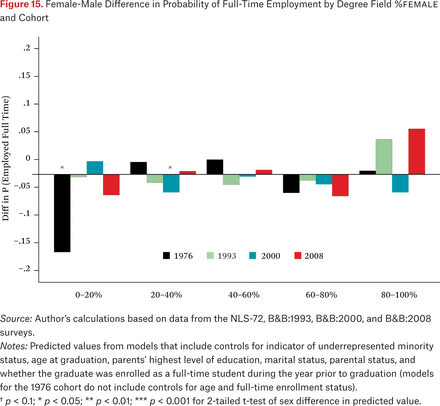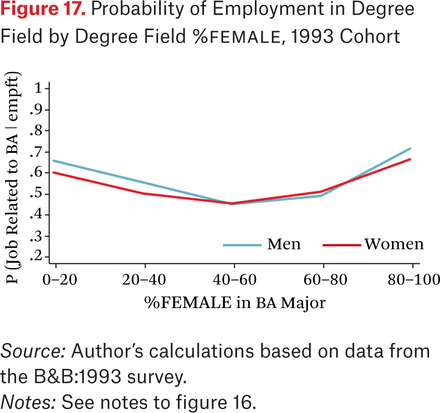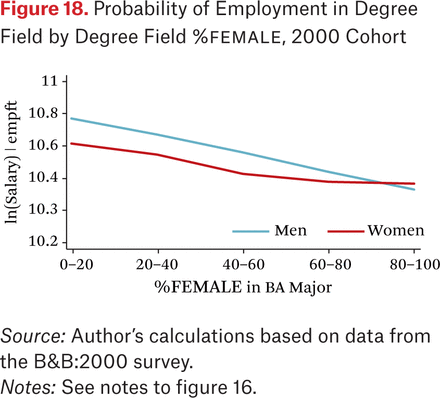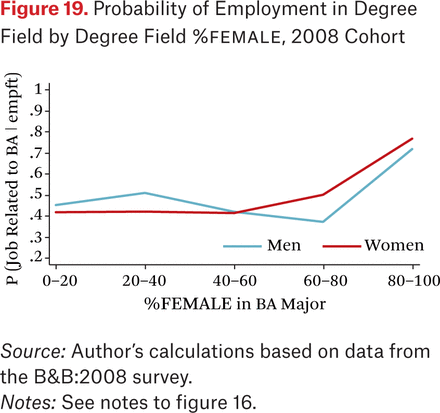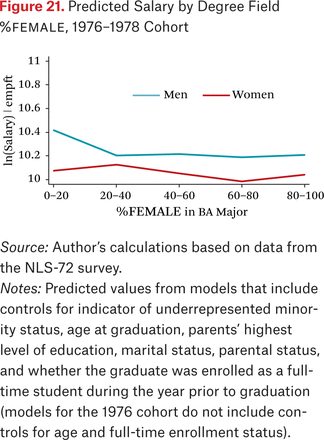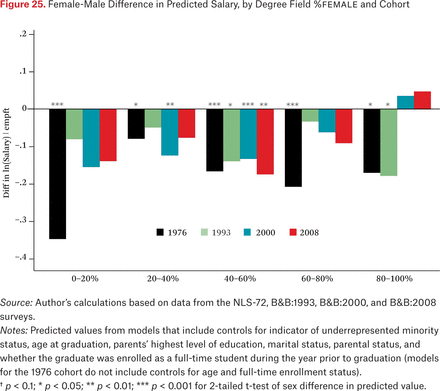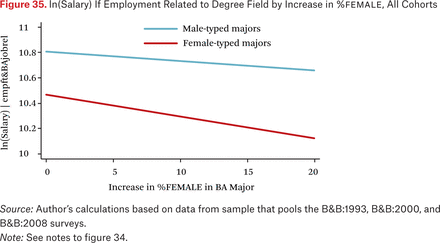Abstract
The presence of baccalaureates who have specialized in fields not traditional for their gender represents the potential momentum each cohort may contribute to labor-force integration and equity. I examine the extent to which this momentum is present and realized among four cohorts of baccalaureates from the late 1970s through the late 2000s. The results show that the potential equalizing effects of increasing gender equity in postsecondary education are not being fully developed or realized. Gender segregation of majors remains significant, and labor-market outcomes continue to be strongly associated with the sex type of a college graduate's degree field. The negative relationship between female representation in a major and both the rate of full-time employment and earnings persisted across the four cohorts, and the negative gradient for earnings intensified. Educational use is slightly depressed among graduates in fields not traditional for their gender, and gender differences in earnings are already sizable within a year of graduation.
Higher education has been a powerful engine of gender equity both in the United States and internationally. Women's increasing participation in postsecondary education and attainment of both baccalaureate and advanced degrees has fueled significant advances toward gender equity in labor-force participation, job achievement, and earnings (Goldin 1990, 2006). College graduates are a driving force behind occupational equality, given that the fastest progress and greatest gender integration and equality has occurred among college-educated workers and in professional occupations (Blau, Brummond, and Liu 2013; Charles and Grusky 2004; England 2006; Jacobs 2003). Yet occupational segregation by gender among the college-educated workforce remains significant despite the growing female advantage in postsecondary graduation and the increasing integration of college majors (DiPrete and Buchmann 2013; Goldin, Katz, and Kuziemko 2006). The entry of new cohorts of college-educated workers and especially of the baccalaureates who have specialized in gender-nontraditional fields—women who earn degrees in traditionally male-dominated fields and men who earn degrees in traditionally female-dominated fields—are the potential momentum each cohort may contribute to labor-force integration and equality. That potential is realized only if a large proportion of such graduates can persist in their nontraditional fields in the labor market. This analysis examines the extent to which the potential desegregating momentum college graduates represent is realized among four cohorts of baccalaureates from the late 1970s through the late 2000s.
I use data from the National Longitudinal Study of the High School Class of 1972 (NLS-72) and the Baccalaureate and Beyond Longitudinal Study (B&B) to examine gender differences in the early labor market outcomes of graduates who earned their degrees in 1976–1978, 1993, 2000, and 2008 from U.S. colleges and universities (NLS 1994, 2003, 2004, 2012). The analysis focuses on three outcomes, each measured one year after the graduates earned their bachelor's degrees: labor-force attachment, educational use (that is, employment closely related to the graduate's degree field), and earnings. The sex-type of each baccalaureate's degree field is the focus of this analysis. I examine whether women and men who earn degrees in gender-nontraditional majors are as likely as their peers to use their educational capital by working in their degree field. I also test whether women and men realize the same economic benefits from working in jobs related to their degree field. The gender-specific outcomes are compared across cohorts to test whether disparities in early career outcomes have changed since the mid-1970s.
SCHOOL-TO-WORK TRANSITIONS AND GENDER DIFFERENCES AMONG THE COLLEGE-EDUCATED
Occupational specificity varies widely across college majors (Roksa and Levey 2010; Shauman 2009). Some majors, like engineering and education, provide specific occupational training and have strong connections to a defined set of occupational categories. Others impart less occupationally specific skills, and graduates from such majors have more diffuse occupational outcomes. The likelihood that college graduates use their specific educational investments by working in their degree field will therefore vary across majors, as will the returns to gaining such employment (Heijke, Meng, and Ramaekers 2003; Morgan 2008; Robst 2007; Roksa and Levey 2010). Although within-major variation in earnings is considerable, the earnings associated with college majors fit into a distinct hierarchy. Graduates from engineering, computer science and mathematics, business, and applied health majors have the highest average earnings; those who earn bachelor's degrees in the biological sciences, humanities, arts, education, psychology, and social work have the lowest (Bobbitt-Zeher 2007; Carnevale, Strohl, and Melton 2011; Loury 1997).
Gender differences in educational investments are strongly associated with gender differences in labor-market outcomes. Because the choice of college major to some extent structures the career opportunities available to graduates in the labor market, the gender segregation of college majors tends to deflect men and women onto different and unequally remunerated occupational paths. Gender segregation of college majors, or “horizontal segregation” (Charles and Bradley 2002), is estimated to account for 10 to 30 percent of the wage gap between college-educated men and women (Bobbitt-Zeher 2007; Brown and Corcoran 1997; Joy 2003; Shauman 2006). Some evidence, however, indicates that the impact of gender segregation of majors on the pay gap has declined over time concurrent with between-major differences in pay (Grogger and Eide 1995; Loury 1997). The fact that gender differences in the returns to specific majors also declined during the 1980s (Loury 1997), especially in male-dominated majors (Morgan 2008; Xie and Killewald 2012), highlights the potential for graduates from gender-nontraditional majors to generate greater gender equity in the labor market if they obtain employment that taps their educational investments.
Although it is clear that gender differences in educational investments help perpetuate gender inequality in the labor market, differences in the use of comparable educational investments also contribute to occupational segregation and the gender pay gap. Young men and women who have the same educational experience and credential may use their investments differently in the labor market, such as by entering largely disparate sets of occupations that may be equally related to their major, or by entering occupations that are unrelated to their major at unequal rates. Such disparities reinforce occupational sex segregation and undermine the potential equalizing effect of degree-field integration (Joy 2006; Shauman 2009). Evidence indicates that among graduates from female-dominated college majors, men are significantly less likely to enter a related occupation. Among graduates in male-dominated fields, however, the disparity in educational use disadvantages women (Shauman 2009). Secular trends toward gender equity, the increasing labor-force participation and labor-force attachment of women, and changing gender norms all suggest that gender differences in educational use will have declined over time. These trends have not been measured, though, nor have their consequences for other labor-market outcomes such as occupational prestige and pay.
SEX-TYPE OF MAJOR AND GENDER DIFFERENCES IN LABOR MARKET OUTCOMES
Mechanisms that may link major sex-type to labor market outcomes are identified by social psychological, organizational, social network, and gender role theories. Tokenism theory posits that the relative representation of types of people within groups directly affects intergroup interactions and the success of individuals in group contexts (Kanter 1977a, 1977b). Minority-group members face heightened visibility that increases performance pressure and social isolation that restricts access to networks of information and support (Eagly and Carli 2007; Kanter 1977b). These pressures may negatively affect their performance, how their work is evaluated, and their likelihood of persistence and success (Rogers and Menaghan 1991). Expectation-states theory posits that cultural stereotypes are reinforced by contextual signals, like sex-ratios within classrooms and workplaces, and that these structure inequality by generating implicit bias in evaluation, association preferences that segregate networks, and interpersonal hostility toward individual members of negatively stereotyped groups (Ridgeway 2014). These perspectives imply that graduates who major in fields not traditional for their gender will have less positive labor-market outcomes than their counterparts with gender-normative majors.
These and other sociocultural perspectives, however, imply that both the likelihood of gender nontraditional behavior and its consequences will be asymmetrical by sex. Expectation-states theory proposes that the positions and characteristics associated with higher status social groups will attract participation among members of lower-status groups, and that the reverse is less likely (Ridgeway 2014). Feminine devaluation theory proposes that because our culture devalues women, all social positions, behaviors, and characteristics associated with women are also devalued and therefore relatively unattractive (England 2006; England, Allison, and Wu 2007; England and Li 2006). The choice of nontraditional college majors will therefore be negatively stigmatized for men but not for women, and gender integration across fields of study (and occupations) will be driven predominantly by women entering male-typed fields (England and Li 2006). This prediction accurately describes the dynamics that generated greater integration of college majors during the 1970s and 1980s (England and Li 2006; Jacobs 2003).
The devaluation perspective also implies that the consequences of nontraditional choices will be asymmetrical by gender given that moving into traditionally male-type fields brings the promise of better pay and higher prestige for women; the opposite is the expected experience for men who make nontraditional choices. But expectation-states theory predicts that among those who enter, or attempt to enter, nontraditional fields, women will experience greater interpersonal backlash than men will because members of high-status groups act to defend their valued positions (Ridgeway 2014). Indeed, studies have shown that women in male-dominated fields face biased evaluation of their work (Knobloch-Westerwick, Glynn, and Huge 2013; Moss-Racusin et al. 2012; Reuben, Sapienza, and Zingales 2014), segregated networks that exclude or marginalize their participation (Koput and Gutek 2010; Sheltzer and Smith 2014), and the experience of discrimination and “chilly” climates (Logel et al. 2009; Steele, James, and Barnett 2002), whereas men in female-dominated fields are implicitly advantaged and experience disproportionate upward mobility (Williams 1992). So, although integration of male-dominated fields may be more likely than integration of female-dominated fields, within-field gender disparities in outcomes will likely be greater in male-dominated than in female-dominated fields.
DATA AND METHODS
The cohorts of recent graduates for whom I observe degree field and labor force outcome are drawn from the National Longitudinal Study of the High School Class of 1972 and the Baccalaureate and Beyond Longitudinal Studies of 1993, 2000, and 2008. The NLS-72 is a nationally representative sample of students who were seniors in high school in the spring of 1972. Information about postsecondary education and employment was collected for this cohort through follow-up surveys in 1973, 1974, 1976, 1979, and 1986 (for a subsample) and from a postsecondary transcript study conducted in 1984. I use the transcript data to identify those who earned their first bachelor's degree in 1976, 1977, or 1978 (that is, four to six years after their high school graduation), the field of their degrees, and the institutions from which they graduated. I select graduates from public and private not-for-profit institutions who were not enrolled in higher education one year after earning their degree. I use self-reported survey items to measure their labor-force outcomes.
Each B&B draws an initial cohort from the National Postsecondary Student Aid Study (NPSAS) and is representative of graduating college seniors in the survey year. The first B&B cohort was drawn from the 1993 NPSAS and surveyed in 1994; it provides a sample of baccalaureates from four-year public and private institutions who earned their baccalaureate between July 1992 and June 1993 and reported their labor-force outcomes in the 1994 survey. The B&B:2000 provides a sample of students who earned their baccalaureate between July 1999 and June 2000 and reported their employment status in a 2001 survey. The B&B:2008 sample represents the cohort of baccalaureates who earned their degree between July 2007 and June 2008 and who reported employment status in 2009. Graduates who reported school enrollment in addition to employment at the time of the B&B surveys are excluded from this analysis because the focus is on graduates who have transitioned to the labor force.1 The analytical samples include, respectively for the 1976–1978, 1993, 2000, and 2008 cohorts, 3,747, 4,317, 4,922, and 5,856, graduates and are 49.7, 55.5, 61.2, and 58.7 percent female. All analyses are weighted to adjust for sampling design.
Degree Field Sex-Type
The sex-type of each degree field is estimated with data from the Integrated Postsecondary Education Data System (IPEDS). The sex-type of each major in a sixty-eight-category (a slightly aggregated version of the four-digit CIP codes) classification of degree field major is measured as the percentage of all degrees in a field that are awarded to women, %FEMALE, and is specific to the graduates’ degree-granting institution and year of graduation. For the NLS-72, the value of %FEMALE is estimated with 1980 IPEDS data, which is the earliest available year of the IPEDS. For all of the B&B cohorts, %FEMALE is estimated using IPEDS data pooled across the three years before each B&B cohort's graduation year: the 1990–1992 IPEDS data operationalize %FEMALE for the B&B:93 cohort; 1997–1999 IPEDS operationalize %FEMALE for the B&B:00 cohort; and 2005–2007 IPEDS operationalize %FEMALE for the B&B:08 cohort.2 I distinguish the quintiles of the distribution of %FEMALE as representing male-dominated (%FEMALE = 0–20), male-majority (%FEMALE = 20–40), gender-balanced (%FEMALE = 40–60), female-majority (%FEMALE = 60–80), and female-dominated (%FEMALE = 80–100) majors. Table A1 presents the average percentage female (aggregated across institutions), and the proportion of baccalaureates earning a degree in each field for each cohort of baccalaure-ates.
Figures 1 through 4 present the distribution of the 1976–1978, 1993, 2000, and 2008 B&B cohorts of college graduates by %FEMALE in their degree field. Figures 1 and 2 present the distribution of graduates by %FEMALE in their degree field measured at the time of each cohort's graduation. In figure 1, the distribution of the 1976–1978 cohort is the most skewed toward the higher levels of %FEMALE, indicating that women in this cohort of baccalaureates were the most heavily concentrated in female-typed fields; indeed, the vast majority earned degrees in fields where women accounted for 60 to 100 percent of all degree holders. The distribution for the 1993 cohort shifted significantly to the left, representing a wider dispersion of female college-students across a broader range of fields, as represented by %FEMALE, and away from the overwhelming concentration in female-typed fields. The shift illustrates the movement of women into gender-balanced fields (%FEMALE = 40–60), but the density of the distribution in the 20 to 40 range of %FEMALE appears to have decreased across the cohorts and its shape in the 0 to 20 range changed very little. The distribution for each successive cohort after 1993 shifts slightly back to the right, that is, toward more female sex-typed majors. Figure 2 reflects a somewhat contrasting pattern in the cohort-specific distributions of male baccalaureates. The shift of the 1993, 2000, and 2008 distributions to the right of the 1976–1978 distribution indicates that men in the later cohorts were much more likely than the 1976–1978 baccalaureates to earn degrees from gender-balanced and female-majority majors.
Distribution of Female Baccalaureates, by Time-Varying Degree Field %FEMALE
Distribution of Male Baccalaureates, by Time-Varying Degree Field %FEMALE
Distribution of Female Baccalaureates by 1980 Degree Field %FEMALE
Distribution of Male Baccalaureates by 1980 Degree Field %FEMALE
Although the distributions presented in figures 1 and 2 represent the relative representation of women the baccalaureates actually experienced in their degree field while they were in college, these figures may not convey a reliable picture of how the field-specific distribution of male and female college graduates has changed across the cohorts. By using time-varying estimates of %FEMALE, figures 1 and 2 conflate potential changes in the degree-field choices of students with changes in the aggregate representation of women in each field. Since the 1960s, women have entered college and completed degrees at increasing rates, and since the 1980s women have earned the majority of four-year degrees (DiPrete and Buchmann 2013). Because women represent an increasing proportion of each successive cohort of students, the %FEMALE in degree fields can increase without any significant changes to the sex-specific distribution of graduates across degree fields (Charles and Bradley 2002, 2009; DiPrete and Buchmann 2013). To test for changes in the degree field preferences among the women and men in these cohorts, I fix the %FEMALE for each degree field at its 1980 level for all of the cohorts. Figures 3 and 4 present the resulting distributions. Figure 3 reveals a notable reallocation of women toward gender-balanced and male-majority fields and even a slight increase in their participation in male-dominated fields between the 1976–1978 and 1993 cohorts, but the distribution changed little across subsequent cohorts. In contrast, the distribution of male baccalaureates (figure 4) was remarkably stable. Successive cohorts remained concentrated in male-majority and male-dominated fields and have not moved into female-majority or female-dominated majors. It even appears that the distribution of male graduates shifted toward male-dominated majors (%FEMALE = 0–20) among recent cohorts as the area in the left tail is slightly greater for the 1993, 2000, and 2008 cohorts than for the 1976–1978 cohort. Any increase in the average %FEMALE in the fields from which male baccalaureates earn their degrees, therefore, is due to the increasing participation of women in the fields from which men have consistently graduated rather than to any notable changes in the distribution of men across fields.
The results presented in figures 1 through 4 illustrate two points. First, they echo previous studies by showing that the increasing representation of women in postsecondary education has not generated significantly greater integration of men and women across fields (DiPrete and Buchmann 2013; England and Li 2006), and that the integration achieved is solely the result of women moving into previously male sex-typed fields (England and Li 2006). These results therefore illustrate the persistent male aversion to entering fields traditionally associated with women (England 2006), the slow movement of women into traditionally male-typed fields, and the resulting resilience of major field segregation that significantly limits the potential for occupational integration among the college educated. Second, the differences between the time-varying and fixed distributions illustrate two aspects of degree field sex-typing that may be independently associated with the labor-market outcomes of graduates: the historical image or character of the field, which can be represented by the %FEMALE at some historical time, and how the gender balance changed over time (England, Allison, and Wu 2007). These components of degree field sex composition are therefore identified separately in the multivariate models used for the analysis reported in this paper.
Figure 5 documents the two components of gender representation for this analysis: the distinct historical sex-typing of the field, which is represented by the %FEMALE in the field in 1980, and the extent to which the gender balance in the field changed between 1980 and 2008 (see also table A1). Panel A of figure 5 presents the mean3 %FEMALE in each of the sixty-eight detailed major fields separately for the periods 1980, 1990–1993, 1997–2000, and 2005–2008. The list of majors is sorted by the 1980 value of %FEMALE, such that the most male-dominated major fields are at the top of the table and the most female-dominated are at the bottom. Panels B, C, and D present the proportion of all, male, and female NLS-72 and B&B sample members who earned their degree in each field, separately by cohort. Most of the degree fields classified as male-dominated or male-majority experienced significant increases in %FEMALE between 1980 and the late 2000s. The %FEMALE in the physical sciences (chemistry, physics, and so on), for example, increased from 17.7 in 1980 to 41.9 in 2008 and therefore transitioned from a male-dominated to a gender-balanced field. But the statistics represented in panels B and C show that this field has experienced declining enrollments of men and little change in the participation of women across the cohorts of graduates. A few male-dominated and male-majority fields experienced notable declines in %FEMALE. These include computer and information sciences, in which the %FEMALE declined from 30.6 to 17.5 between 1980 and 2008; the proportion of male baccalaureates earning degrees in the field increased consistently across cohorts. Baccalaureates from gender-balanced fields also tended to become increasingly female over the period, whereas most of the female-majority and female-dominated fields experienced a decline in %FEMALE. Some—like psychology, social work, and English—became more female dominated.
Average Degree Field and %FEMALE Proportion of Graduates in Each Field, NLS-72 and B&B Cohorts
The most popular majors across the cohorts of graduates were business-management, communications, English, psychology, and education. The popularity of some majors increased significantly since 1980, most notably business-management, but others, such as protective services, psychology, and nursing, also contributed a growing proportion of all baccalaureates conferred. Others fields—including accounting, biological sciences, and education—accounted for declining shares of all baccalaureates over the three decades.
Labor-Market Outcomes
I examine multiple labor-force outcomes of the graduates one year after graduation: employment (among those in the labor force); full-time employment (thirty-five or more hours); employment in a job related to the graduate's degree field (among those employed full time); and salary (among those employed full time). All are measured with self-reported survey items. Yearly salary for all cohorts is adjusted to constant 2009 dollars and log-transformed to correct for distribution skew. The relationship between a graduate's job and degree field is measured for the B&B cohorts with a survey item that asked the graduates to identify whether their job (at the time of the interview) was closely, somewhat, or not at all related to their degree field. Those responding closely are identified as in a job related to their degree field. This survey item is replicated in each B&B survey, so the data are directly comparable across cohorts. The NLS-72 includes a comparable item available only for individuals who earned their degrees in 1976 and 1978 and were working in 1977 and 1979. For these years, I code graduates as in a degree-related job if they respond affirmatively to two series of questions: “Not including on-the-job or employer training, did you receive formal instruction to do this kind of work?” “Where did you receive this training: four-year college or university?” and “What were your experiences while working on this job?…. Most of what I did on the job I learned to do in school.”
Descriptive statistics for the outcome variables presented in table 1 show that employment rates are high, 89 percent or more, for all cohorts, as are the rates of full-time work among employed graduates. The percentage of full-time employed college graduates reporting that their job is closely related to their degree field ranges between 40 and 55, and average annual salaries from $23,000 to $41,000. These statistics also show that, for every cohort, gender gaps in the labor-market outcomes are already apparent one year after degree completion. Women graduates are less likely than men to be employed and their rates of full-time employment are 3 to 4 percentage points lower. Female baccalaureates earn significantly less than their male peers even when employed full time: the marginal female deficit in yearly earnings ranges from $4,500 among the 1993 cohort to more than $6,800 among the 2008 cohort. Among college graduates employed full time, however, women are more likely than men to report working in a job closely related to their degree field. This female advantage is statistically significant for the 1976–1978, 2000, and 2008 cohorts.
Descriptive Statistics for Measures
Method
To test for gender differences in the early labor-market outcomes of graduates based on the sex-type of their degree field, I fit regression models for each of the outcome measures separately for each cohort: nonlinear models for the analysis of employment, full-time employment, and whether the job is closely related to degree field; linear models for the log of yearly salary. These models estimate the gender- and cohort-specific associations between degree field sex-type and labor-market outcomes in the presence of controls for individual demographic and achievement characteristics that may influence those associations. The model estimates are used to test for gender differences and to examine whether observed differences have changed over time. Estimation of the causal mechanisms that may drive the observed associations and their variation over time is beyond the scope of this analysis. The basic model is as follows:
where Yij represents the labor force outcome (employment, full-time employment, employment in a job related to the degree field, and salary) for graduate i in cohort j, Female is a dichotomous indicator of the sex of graduate i in cohort j (1=female), %FEMALE is a series of dummy variables indicating the level of %FEMALE (by quintile of the distribution)4 in the degree field of student i in cohort j, Δ%FEMALE is the change in the value of %FEMALE between 1980 and the graduation year of each cohort. This specification of degree field sex-type allows for the estimation of independent associations between labor market outcomes and—first—the historical sex-typing of the field, which is represented by the degree field sex type in the year 1980, %FEMALE1980, and—second—the change over time in the percentage-female in a degree field, Δ%FEMALE. In the models, Δ%FEMALE is operationalized as two linear spline variables, one capturing increasing and the other capturing decreasing values of %FEMALE, and the inclusion of the %FEMALE1980 * Δ%FEMALE interactions allows the estimated association between outcomes and changes in field %FEMALE to vary across the baseline (1980) values of %FEMALE. The coefficients for the %FEMALE1980 * Female interaction term, β5, is of primary interest for this analysis because they estimate the magnitude and significance of gender differences in the labor market outcomes of graduates according to the sex-type of their degree field.5
The vector of control variables, represented by Xij in equation (1), includes demographic and achievement characteristics of student i in cohort j. The race-ethnicity of the baccalaureates is measured by a dichotomous indicator of underrepresented minority status, which is coded 1 for graduates who self-identify as African American, Hispanic, or Native American. The graduates’ age at degree attainment is included as a control variable for the B&B cohorts because age varies significantly in those samples of graduating college students, but is unnecessary for the NLS-72 cohort of high school seniors. The highest education of either parent of the NLS-72 and B&B sample members is measured with a four-category variable that distinguishes baccalaureates whose parent or parents earned high school or less, some college, bachelor's degree, or postgraduate degree. Dichotomous variables identify the marital (single, never married = 1) and parental status (have children = 1) of the graduates, and the estimated coefficients for these family status variables are allowed to vary by the baccalaureate's gender in all models. The B&B graduates’ grade point average in their major field is included in the models as a control for their level of performance and level of specialized skill in their field of study (Joy 2003; Loury 1997). For the NLS-72 cohort, achievement is measured with a categorical variable recording the graduates’ “estimated grades in all coursework between October 1974 and October 1976.” A dichotomous indicator variable distinguishes recent graduates who were enrolled full time during the year before earning their degree from those who were not (was enrolled full time = 1). Descriptive statistics for all control variables are presented in table 1.
RESULTS
The estimated coefficients for all cohort- and outcome-specific models are presented in tables A2 through A4. Because interpretation of the coefficients is complicated by the inclusion of multiple interaction terms, I use predicted probabilities to present the results relevant to the focal research questions of this analysis. Are women and men who earn degrees in nontraditional majors as likely as their peers to use their educational capital by obtaining employment and working in their degree field? Do men and women realize the same economic rewards from utilizing their educational investments? Have the gender disparities in early career outcomes changed over the past three decades?
Figures 6 through 35 present the predicted labor market outcomes for men and women in each graduating cohort by the sex-type of their degree field, adjusted for the influence of the identified covariates. Figures 6 through 9, 11 through 14, 16 through 19, 21 through 24, 26 through 29, and 31 through 35 show the gender-specific association between degree field %FEMALE and employment outcome. Figures 10, 15, 20, 25, and 30 summarize how the %FEMALE-specific gender gap in each employment outcome changes across the cohorts. These figures illustrate the association between degree field sex-type, that is, the degree to which employment outcomes vary across graduates from fields that are male dominated, male majority, and so on, as well as gender differences within type of degree field. The outcomes of gender nontraditional majors are reflected in the tails of the distribution presented in each chart: the outcomes of females in male-dominated and male-majority majors, and the outcomes of males in female-majority and female-dominated majors.
Probability of Employment by Degree Field %FEMALE, 1976–1978 Cohort
Probability of Employment by Degree Field %FEMALE, 1993 Cohort
Probability of Employment by Degree Field %FEMALE, 2000 Cohort
Probability of Employment by Degree Field %FEMALE, 2008 Cohort
Female-Male Difference in Probability of Employment by Degree Field %FEMALE and Cohort
Probability of Full-Time Employment by Degree Field %FEMALE, 1976–1978 Cohort
Probability of Full-Time Employment by Degree Field %FEMALE, 1993 Cohort
Probability of Full-Time Employment by Degree Field %FEMALE, 2000 Cohort
Probability of Full-Time Employment by Degree Field %FEMALE, 2008 Cohort
Female-Male Difference in Probability of Full-Time Employment by Degree Field %FEMALE and Cohort
Probability of Employment in Degree Field by Degree Field %FEMALE, 1976–1978 Cohort
Probability of Employment in Degree Field by Degree Field %FEMALE, 1993 Cohort
Probability of Employment in Degree Field by Degree Field %FEMALE, 2000 Cohort
Probability of Employment in Degree Field by Degree Field %FEMALE, 2008 Cohort
Female-Male Difference in Probability of Employment in Degree Field, by Degree Field %FEMALE and Cohort
Predicted Salary by Degree Field %FEMALE, 1976–1978 Cohort
Predicted Salary by Degree Field %FEMALE, 1993 Cohort
Predicted Salary by Degree Field %FEMALE, 2000 Cohort
Predicted Salary by Degree Field %FEMALE, 2008 Cohort
Female-Male Difference in Predicted Salary, by Degree Field %FEMALE and Cohort
Predicted Salary Among Those Working Full Time in Employment Related to Degree Field, by Degree Field %FEMALE, 1976–1978
Predicted Salary Among Those Working Full Time in Employment Related to Degree Field, by Degree Field %FEMALE, 1993 Cohort
Predicted Salary Among Those Working Full Time in Employment Related to Degree Field, by Degree Field %FEMALE, 2000 Cohort
Predicted Salary Among Those Working Full Time in Employment Related to Degree Field, by Degree Field %FEMALE, 2008 Cohort
Female-Male Difference in Predicted Salary Among Those Working Full Time in Employment Related to Degree Field, by Degree Field %FEMALE
Probability of Employment by Increase in %FEMALE, All Cohorts
Probability of Full-Time Employment by Increase in %FEMALE, All Cohorts
Probability of Employment Closely Related to Degree Field by Increase in %FEMALE, All Cohorts
ln(Salary) by Increase in %FEMALE, All Cohorts
ln(Salary) If Employment Related to Degree Field by Increase in %FEMALE, All Cohorts
Early Labor-Market Attachment Among Recent Graduates
Figures 6 through 9 show that the predicted probability of employment is high for all cohorts and across all the quintiles of degree field %FEMALE. The likelihood of employment one year after graduation does not vary by degree field sex-type, except for the 1976–1978 and 2008 cohorts. For the 1976–1978 cohort, employment rates for men with degrees in female-dominated majors exceed those of all other male and female graduates. For the 2008 cohort, the men with degrees in gender-balanced majors are significantly less likely to be employed one year after degree attainment than men with degrees in male-dominated majors are. Figure 10 shows that the gender gap in employment rates is significant only among the 1976–1978 cohort of graduates from female-dominated majors: male graduates are significantly more likely than female graduates from these majors to be employed one year after graduation.
Among the recent graduates who are employed, the probability that they work full time is strongly related with the sex-type of their degree field (see figures 11 through 14). The likelihood of full-time employment is negatively associated with the %FEMALE of their major and is lowest, on average, for graduates from female-majority and female-dominated majors. The probability of working full time also tends to be slightly lower for women. Figure 15 shows that the female deficit is greatest among the earliest cohort of graduates from male-dominated fields. In contrast, nontraditional men, that is, those with degrees from female-dominated fields, are more likely than similarly credentialed women in the 1993 and 2008 cohorts to work full time, though the male-advantage is not statistically significant.
Employment in a Job Related to Degree Field
Figures 16 through 19 present the proportion of full-time employed baccalaureates across the range of %FEMALE who report working in a job closely related to their degree field. Two patterns are notable. First, the likelihood that graduates work in fields they characterize as closely related to their degree tends to be highest among those from the most sex-typed majors, that is, the male- and female-dominated fields. Second, a gendered cross-over pattern is evident in the probability of working in a job related to one's degree: educational use tends to be lower among women than men who graduate from male-dominated and male-majority majors, and, conversely, lower among men than among women who earn degrees from female-majority and female-dominated fields. Although the pattern is consistent across all but the 1993 cohort, figure 20 shows that the gender gaps are significant only for the 1976–1978 and 2008 cohorts.
Salary
Figures 21 through 24 present the average earnings, adjusted to consistent 2009 dollars, among recent college graduates who were working full time. The downward slope of the lines in each of the cohort-specific graphs, which is statistically significant for all cohorts, reflects the well-known association between degree field sex-type and earnings—that average earnings are greater for graduates from male-dominated than female-dominated fields (England and Li 2006). The magnitude of the negative association between earnings and %FEMALE increased, and the downward slope steepened, such that the 2000 and 2008 cohorts of graduates experienced the greatest disparities in earnings by sex-type of field. The cohort-specific graphs also illustrate the persistence of the gender gap in graduates’ earnings across the range of %FEMALE and across cohorts, and this trend is summarized in figure 25. Except for the 2000 and 2008 graduates from female-dominated majors, women tend to earn less than men only a year after graduation in every type of major. The gender gaps in earnings are greatest among the 1976–1978 cohort and especially among those with degrees in male-dominated fields. The nontraditional educational investments made by women in this cohort did not pay off in early earnings: their yearly salaries, among full-time workers, were on average $6,900 less than those of men with degrees from similar fields, and their earnings were not significantly different from those of women who made more gender-traditional educational choices. The relative advantage to women of majoring in traditionally male-dominated and male-majority fields increased over the cohorts as the %FEMALE-salary gradient steepened. Across successive cohorts, women who followed nontraditional educational paths continued to experience sizable (and sometimes statistically significant) deficits in earnings relative to male graduates from these fields but earned significantly more than women with degrees in traditionally female-typed fields.
The 1976–1978 and 1993 graduates from female-dominated fields also experienced a significant earnings deficit, indicating that in the early cohorts men suffered less than women did from the negative association between earnings and degree field %FEMALE. That gender gap closed among the 2000 and 2008 cohorts, but this finding cannot be interpreted as evidence of progress toward gender equity in the labor market. For the 2000 cohort, the gap disappeared because the earnings of men with degrees in female-dominated fields declined relative to prior cohorts, so equity was realized because the earnings of male and female graduates in these fields became equally depressed. In contrast, earnings equity among the 2008 cohort resulted from an increase (compared with the 2000 cohort and relative to earnings in female-majority majors) in the average earnings among both male and female graduates in female-dominated majors. But because earnings are relatively low among graduates from female-majority and female-dominated fields and because women continue to vastly outnumber men in these majors, gender equity among graduates from female-typed fields will have little impact on the aggregate-level pay gap among recent college graduates.
To assess whether men and women realize the same benefits from their educational investments, I estimate the predicted earnings among full-time employed college graduates separately for those who report working in a job closely related to their degree field (see figures 26 through 29). Average earnings are higher among graduates whose work is closely related to their degree field, but these results largely mirror those presented in figure 21 for all full-time employed graduates. The negative association between %FEMALE and salary remains significant across all cohorts for graduates who use their education on the job. In addition, figure 30 shows that the female deficit in earnings is sizable for all types of majors and persists across the cohorts, though it tends to be statistically significant only for male-majority and gender-balanced fields. These results are therefore inconsistent with the idea that educational use, especially among women in male sex-typed majors, can minimize gender gaps in earnings. Instead, the results indicate that men and women both benefit from using their education but they do not benefit equally, and the data provide no evidence that this pattern has changed over the three decades covered by the four cohorts of college graduates included in this analysis.
Impact of Changing Gender Distribution Within Majors on Labor-Market Outcomes
According to the IPEDS data for all public and private not-for-profit four-year postsecondary institutions in the United States, the representation of women increased 5.5 percentage points, from 49.9 to 55.4 percent, between 1980 and 2008 (see table A1). As noted and as illustrated in figure 5, the relative representation of women increased 10 to 20 percentage points in many fields, while other fields experienced declines in the %FEMALE. Such changes in field-specific sex composition are linked to labor market outcomes, such as pay within field or occupation, by theories aimed at explaining gender inequality in the labor force. The feminine devaluation perspective (England 1992; England, Allison, and Wu 2007), queuing theory (Reskin and Roos 1990), and crowding theory (Bergmann 1974; Sorensen 1990) all predict a negative association between increasing field-specific female representation and pay, though they identify different causal mechanisms. Devaluation theory identifies the cultural devaluation of women as the fundamental mechanism, inferring that the increasing representation of women drives down the value and remuneration in the field simply because it becomes increasingly associated with women (Levanon, England, and Allison 2009). Queuing theory predicts that employer preferences for male workers, coupled with worker preferences for high-paying jobs, will result in a concentration of women in low-paying jobs, that is, that low-paying jobs are the only options for women because employers will not be able to attract male employees for those positions. Crowding theory identifies the association as caused by a supply-demand imbalance that results from employer discrimination against women: women's earnings suffer from artificially high competition for positions in the few fields where employers allow them (Bergmann 1974; Sorensen 1990). These theories do not address the potential for nonlinearities in the association between increasing field-specific female representation and labor-market outcomes, but there is reason to expect the effect of changes in degree field %FEMALE on labor-market outcomes to vary by the sex-type of the field. Extrapolating from tokenism and devaluation theories, initial sex composition of a field may condition the effect of changes in %FEMALE if particular levels of %FEMALE trigger the feminine devaluation effect. For example, a given increase in %FEMALE may be more detrimental to labor-market outcomes for graduates from fields that were already female-majority (because the shift caused a field to become clearly female dominated) than for graduates from previously male-majority fields (because the shift caused a field to become gender-neutral).
The model coefficients for Δ%FEMALE, β2, and the %FEMALE1980 * Δ%FEMALE interaction, β4, test the association between labor-market outcomes and changes in the representation of women within degree fields, and allow for that association to vary across the sex-type of the field. The estimates for these parameters are presented in tables A2 through A4. To illustrate the results, I calculate predicted probabilities for each of the employment outcomes by values of Δ%FEMALE ranging from 0 to 20 (representing a change of up to 20 percentage points) based on model coefficients estimated using data pooled across the three B&B cohorts. Because I find that declining values of Δ%FEMALE are not associated with any of the labor-market outcomes for any cohort of graduates,6 I focus on the estimated impact of increasing values of Δ%FEMALE. To test whether the influence of the increasing representation of women within degree fields differs by the sex-type of a degree field, I estimate predicted probabilities separately for degree fields that are male-typed (male-dominated or male-majority) and female-typed (female-dominated or female-majority). The resulting probabilities are presented in figures 31 through 35.
The predicted probabilities illustrate that increasing %FEMALE is significantly associated with all the labor market outcomes examined except the likelihood that recent graduates will be employed a year after earning their degree. More specifically, the estimates show that the increasing representation of women within a degree field is negatively associated with the probability of full-time employment among graduates from that field, their likelihood of securing a job closely related to their degree, and their earnings. Furthermore, the impact of the feminization of degree fields tends to be most negative for graduates with degrees in female-typed than male-typed majors. The estimated interaction is most notable for the probability of full-time employment, educational use, and salary among those who are using their education on the job. These findings imply that existing gaps between graduates from male- and female-typed majors in the probability of full-time employment and in salary have grown as the influx of women into higher education over the past three decades has increased women's representation in all majors. Identifying the potential supply- and demand-side mechanisms that may have generated the increasingly negative labor-market outcomes for graduates from feminizing female-typed majors is beyond the scope of this analysis but warrants attention from scholars of gender inequality in labor market processes.
CONCLUSION
The results of this analysis show that the potential equalizing effects of increasing gender equity in postsecondary education are not being fully developed or realized. Gender segregation of majors remains significant, and the absence of significant movement toward integration between 1993 and 2008 indicates that further progress toward equity is unlikely in the near future. Labor market outcomes continue to be strongly associated with the sex type of a graduate's degree field, so segregation generates labor-market disparities. And graduates from gender nontraditional majors—who represent potential for labor-market integration and equity—account for only a small proportion of all baccalaureates even among the most recent cohorts, and their labor-market outcomes tend to mirror the gender disparities of gender-traditional college graduates.
The sex segregation of college majors changed little across the four cohorts examined in this study. The increasing integration achieved occurred between the 1976–1978 and the 1993 cohorts, and since then the distribution of male and female baccalaureates has changed little. Although the proportionate representation of women among recent cohorts of degree recipients has increased across most fields, women continue to choose majors in historically female-typed fields and men continue to choose majors in male-dominated ones. Furthermore, the integration that has occurred has been asymmetrical: women have moved into male-typed fields but disinclination toward female-typed majors and even gender-neutral fields persists. These findings echo the results of earlier analyses (DiPrete and Buchmann 2013; England, Allison, and Wu 2007; Jacobs 1995) and are consistent with the patterns predicted by the feminine devaluation and expectation-states perspectives. The results also illustrate the inertia built into the cohort replacement process of social change in the labor force: the continued sex segregation of each successive cohort of college graduates reinforces existing patterns of occupational segregation. From the cohort-replacement perspective, that little integration was achieved during dramatic increases in women's participation in higher education (DiPrete and Buchmann 2013) indicates that an opportunity to generate greater gender equity in the U.S. labor force has largely been missed.
The association between degree field sex-type and labor-market outcomes is strong and has persisted across the four cohorts examined here. The representation of women in a major is negatively associated with both full-time employment and earnings among full-time workers. The specific causal relationships that underlie these associations continue to be debated (England, Allison, and Wu 2007; Levanon, England, and Allison 2009). However, in the context of continued degree-field segregation, their consequences are clear: they contribute to significant gender disparities in the labor market. Indeed, the apparent steepening of the negative %FEMALE-earnings gradient has multiple implications for earnings disparities. First, it suggests that the gender gap in earnings among college-educated workers may be widening. Second, it indicates that the utility of gender nontraditional educational paths is increasing for women and that their movement into historically male-dominated fields has and will continue to generate within-gender earnings inequality.
But occupational segregation and between-field disparities in outcomes are not the only dynamics contributing to gender disparities in the labor market. In general, educational use is slightly depressed among gender nontraditional graduates. Among those from male-typed fields, women have been less likely than men to work in their degree field, and among those from female-typed majors, men have been less likely than women to use their education. But even among graduates who do work in their degree field, including those who graduate from gender nontraditional majors, gender differences in earnings are already sizable within only a year of graduation. I also find that increases in the relative representation of women within degree fields, which is common given the increasing predominance of women in postsecondary education, depresses average earnings of all graduates, especially those in female-dominated majors. This finding highlights an additional mechanism that works with sex segregation of college majors to reinforce labor-force gender inequality despite women's increasing advantage in educational attainment.
Acknowledgments
The author thanks the anonymous reviewers, the editors, and seminar participants at the Russell Sage Foundation conference “Changing Roles and the Status of Women: Effects on Society and the Economy” for their comments on earlier drafts of this paper. A version of this paper was presented at the 2015 meeting of the Population Association of American meetings in San Diego, California.
APPENDIX
%FEMALE in Major from IPEDS Data and Percent of All NLS-72 and B&B Graduates in Each Major Degree Field by Cohort
Estimated Coefficients for Models of Employment and Working Full Time
Estimated Coefficients for Models of Employment Related to Degree Field and Salary
Estimated Coefficients for Models of Salary for Those Working in Degree Field
FOOTNOTES
↵1. Other groups excluded from the analysis are respondents reporting being on active military service or veterans, individuals who are not U.S. citizens, individuals who earned their degree from a for-profit postsecondary institution or who had previously earned another bachelor's or advanced degree, and individuals in the B&B cohorts who were older than thirty when they earned their degree.
↵2. If institution-specific data are missing, the value of %FEMALE is imputed using the year- and field-specific mean across all institutions.
↵3. Means are weighted by institution size, which is operationalized as the total number of degrees completed as reported in the IPEDS.
↵4. Multiple alternative specifications of %FEMALE were tested including dummy variables representing vigintiles (5 percent intervals) and deciles, and multivariable spline specifications with various knot locations. Decile and vigintile specifications suffered from small sample sizes in the tail categories (those representing strongly male- or female-dominated majors. Models with spline specifications did not fit the data better than the models with the dummy-variable quintile specification of %FEMALE.
↵5. All analyses are weighted, and standard errors estimated, to adjust for survey design characteristics using the survey data commands (svy) in Stata.
↵6. This conclusion is supported by the fact that that none of the estimated coefficients for Decrease in %FEMALE variable nor its interaction with the %FEMALE indicator variables are statistically significant in any of the cohort-specific models (see tables A2 though A4).
- Copyright © 2016 by Russell Sage Foundation. All rights reserved. Printed in the United States of America. No part of this publication may be reproduced, stored in a retrieval system, or transmitted in any form or by any means, electronic, mechanical, photocopying, recording, or otherwise, without the prior written permission of the publisher. Reproduction by the United States Government in whole or in part is permitted for any purpose. The author thanks the anonymous reviewers, the editors, and seminar participants at the Russell Sage Foundation conference “Changing Roles and the Status of Women: Effects on Society and the Economy” for their comments on earlier drafts of this paper. A version of this paper was presented at the 2015 meeting of the Population Association of American meetings in San Diego, California. Direct correspondence to: Kimberlee Shauman at kashauman{at}ucdavis.edu, Department of Sociology, University of California, Davis, One Shields Ave., Davis, CA 95616–8701.
Open Access Policy: RSF: The Russell Sage Foundation Journal of the Social Sciences is an open access journal. This article is published under a Creative Commons Attribution-NonCommercial-NoDerivs 3.0 Unported License.









